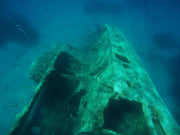
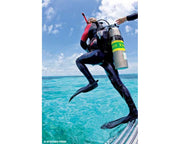
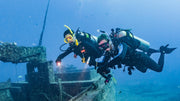
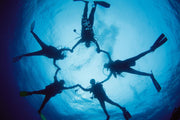
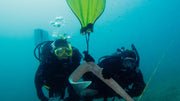
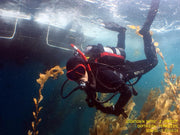
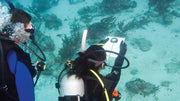
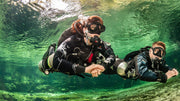
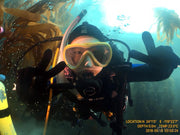
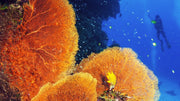
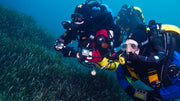
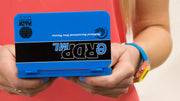
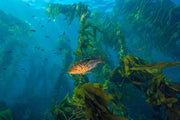
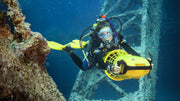
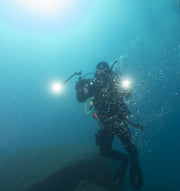
Discover the Thrill of Wreck Diving with Blue Holic Scuba!
Explore sunken vessels, aircraft, and other fascinating wrecks as you dive deeper into the underwater world. The PADI Wreck Diver Specialty Course equips you with the skills, knowledge, and techniques needed to safely navigate and, where appropriate, penetrate wrecks. Whether you're a history buff or just love the eerie beauty of underwater structures, wreck diving offers an unforgettable adventure!
San Diego's Yukon Shipwreck One of the largest and most exciting wrecks in Southern California, the Yukon is a 366-foot Canadian destroyer that was deliberately sunk as part of the artificial reef project. It now rests on its side at 100 feet below the surface. With plenty of penetration opportunities, the Yukon offers experienced divers a chance to explore compartments, hallways, and deep holds. The structure is teeming with marine life and provides a thrilling dive with excellent photo opportunities.
Perfect for: Advanced wreck divers or those looking to refine their wreck penetration skills.
Depth: 60-100 feet
Penetration: Extensive, with challenging entry points
Additional Gear Needed: Dive light, reel, and wreck-specific equipment
Casino Point (Catalina Island) For those seeking a more laid-back wreck diving experience, Casino Point offers minimal yet fascinating wreck structures in a calmer environment. Divers can explore smaller boat remnants while enjoying the lush kelp forests and diverse marine life that Casino Point is known for. This is a great introduction for wreck enthusiasts looking to ease into this specialty without the challenges of deep wrecks.
Perfect for: Divers new to wreck exploration or those seeking a relaxed wreck dive in a scenic environment.
Depth: 30-60 feet
Penetration: Minimal, basic navigation
Additional Gear Needed: Standard dive equipment (rentals available)
Exact dates and times vary. Check out our Dive Calendar for upcoming courses.
Mandatory Gear:
Wreck-Specific Gear:
Not sure what you need? No problem! We offer full gear rentals, including wreck-specific equipment. Our expert staff is happy to help you select or rent the best equipment for your wreck diving adventures.
Ready to explore wrecks and advance your diving skills? Call us at +1 (323) 641-7416 to learn more.
At Blue Holic Scuba, we promote eco-conscious diving practices. While exploring wrecks, it's important to leave nothing but bubbles. We encourage all our divers to bring a reusable water bottle and reduce single-use plastics. Help us protect these underwater habitats for future generations!
The PADI Enriched Air Diver course is PADI’s most popular specialty scuba course. Why? Because scuba diving with enriched air nitrox gives you more no decompression time, especially on repetitive scuba dives. If staying down longer and getting back in the water sooner sounds appealing, then don’t hesitate to become an enriched air diver.
If you’re a PADI (Junior) Open Water Diver who is at least 12 years old, you can enroll in the Enriched Air Diver Specialty course.
You’ll learn why diving with air that has higher oxygen and lower nitrogen content gives you more bottom time, along with enriched air equipment considerations. During a practical session, and two optional (or required) scuba dives, you’ll:
You may be able to get college credit for the PADI Enriched Air Diver course – ask your instructor to learn more.
This course runs between 2-4hours in the Blue Holic Classroom. The amount of time depends on how comfortable you are with mathematics and physics. By the end of the course you will understand the concepts of diving with Nitrox, the benefits as well as the technical limitations.
Most modern scuba equipment and dive computers can be used with enriched air, but your Blue Holic Scuba Instructor will let you know if your gear meets manufacturer recommendations and local requirements. However, scuba tanks must meet oxygen service standards and be dedicated for use with enriched air. You’ll practice using oxygen analyzers and special cylinder decals. Our Blue Holic staff will explain other equipment you may need to enjoy enriched air diving.
Call us at (323) 641-7416 or stop by Blue Holic Scuba to enroll in the course, get your materials and start learning. You will purchase the Enriched Air Diver Manual and watch the Enriched Air Diving video. Your PADI Instructor will meet with you to schedule knowledge review sessions along with your EAD theory course.
Excellent buoyancy control is what defines skilled scuba divers. You’ve seen them underwater. They glide effortlessly, use less air and ascend, descend or hover almost as if by thought. They more easily observe aquatic life without disturbing their surroundings. You can achieve this, too. The PADI Peak Performance Buoyancy Specialty course improves the buoyancy skills you learned as a new diver and elevates them to the next level.
PADI (Junior) Open Water Divers or higher, who are at least 10 years old, are eligible to take the Peak Performance Buoyancy course.
During two scuba dives, you’ll learn how to:
Get credit! The first dive of this PADI Specialty Diver course may credit as an Adventure Dive toward your Advanced Open Water Diver certification – ask your instructor about earning credit.
New to rebreathers? This course has many helpful tips to achieving good buoyancy control when rebreather diving.
It’s best to use your own scuba equipment, including a weight system, so that you fine-tune your buoyancy in gear you’ll use on every dive. Your PADI Instructor can help you find the equipment that is best for you and your diving adventures.
Frequently Asked Questions
Q. What do I do after purchasing the Peak Performance Buoyancy Specialty Course?
After you purchase the Specialty Course, an instructor will contact you according to your account via email or phone call. Then, you will schedule for meeting.
You will come to our dive shop on the scheduled day and will go through orientation, instuctions, and you will schedule further appointments for swimming pool and ocean dive sessions.
The lure of the deep. There’s something exciting and mysterious about exploring deeper dive sites while scuba diving. Sometimes it’s a wreck that attracts you below 18 metres/60 feet, and on wall dives it may be a giant fan or sponge. Whatever it is, to scuba dive with confidence at depths down to 40 metres/130 feet, you should take the PADI Deep Diver Specialty course.
If you’ve earned the PADI Adventure Diver rating or higher, and you’re at least 15 years old, you can enroll in the Deep Diver course.
Your training starts by reviewing reasons for deep diving and how important it is to know your personal limits. During four deep dives with your instructor, you’ll go over:
Also, the first dive of this PADI Specialty Diver course may credit as an Adventure Dive toward your Advanced Open Water Diver certification – ask your instructor about earning credit.
You’ll need a dive computer along with the rest of your basic scuba equipment. A dive light and slate are also recommended. Your PADI Instructor may suggest other gear appropriate for local deep diving.
Q. What do I do after purchasing the Deep Diver Specialty Course?
After you purchase the Specialty Course, an instructor will contact you according to your account via email or phone call. Then, you will schedule for meeting.
You will come to our dive shop on the scheduled day and will go through orientation, instuctions, and you will schedule further appointments for swimming pool and ocean dive sessions.
It happens: People accidentally drop things from docks, off boats or even while scuba diving. If you’ve ever lost something in the water and wanted to go find it, then the PADI Search and Recovery Diver Specialty course is for you. There are effective ways to search for objects underwater that increase your chances of success. And there are good and better methods to bring up small, large or just awkward items. Search and recovery can be challenging, but a whole lot of fun.
PADI (Junior) Advanced Open Water Divers who are at least 12 years old can enroll in the Search and Recover Diver course. PADI (Junior) Open Water Divers with a PADI Underwater Navigator certification also qualify.
Gathering information and resources, then carefully planning a search are the first important steps you learn. During four scuba dives you’ll practice:
You may be able to get college credit for the Search and Recovery course – ask your instructor.
Also, the first dive of this PADI Specialty Diver course may credit as an Adventure Dive toward your Advanced Open Water Diver certification – ask your instructor about earning credit.
Besides your basic scuba equipment, you’ll need a compass and underwater slate. Your PADI Instructor may suggest other gear that may help with your searches, such as a dive light, marker buoys, lines and reels.
Frequently Asked Questions
Q. What do I do after purchasing the Search and Recovery Specialty Course?
After you purchase the Specialty Course, an instructor will contact you according to your account via email or phone call. Then, you will schedule for meeting.
You will come to our dive shop on the scheduled day and will go through orientation, instuctions, and you will schedule further appointments for swimming pool and ocean dive sessions.
Much of the world’s best scuba diving is accessible only by boat. Whether you’ve never made a boat dive or you’ve logged dozens, the PADI Boat Diver Specialty course will benefit you because boats in various parts of the world do things differently. Scuba diving from a boat is fun and relatively easy because you usually descend directly onto your dive site.
If you’re a PADI (Junior) Open Water Diver who is at least 10 years old, you can enroll in the Boat Diver course.
The PADI Boat Diver course will expand your knowledge about boats from small inflatables to large liveaboards. You’ll gain experience scuba diving by completing two dives from a boat in your local area and learn:
Get credit! The first dive of this PADI Specialty Diver course may credit as an Adventure Dive toward your Advanced Open Water Diver certification – ask your instructor about earning credit.
Beyond using basic scuba equipment, you’ll want to have a surface signaling device, such as an inflatable signal tube. Having a complete spare parts kit is also a good idea. Your PADI Instructor may suggest additional equipment depending on what type of boat and where your boat diving adventures take you.
Q. What do I do after purchasing the Boat Diver Specialty Course?
After you purchase the Specialty Course, an instructor will contact you according to your account via email or phone call. Then, you will schedule for meeting.
You will come to our dive shop on the scheduled day and will go through orientation, instructions, and you will schedule further appointments for swimming pool and ocean dive sessions.
Be the scuba diver everyone wants to follow because you know where you are and where you’re going. The PADI Underwater Navigator course fine-tunes your observation skills and teaches you to more accurately use your compass underwater. If you like challenges with big rewards, take this course and have fun finding your way.
If you’re a PADI (Junior) Open Water Diver who is at least 10 years old, you can enroll in the PADI Underwater Navigator Specialty course.
You’ll learn the tools of the trade, including navigation using natural clues and by following compass headings. During three scuba dives, you’ll practice:
The first dive of this PADI Specialty Diver course may credit as an Adventure Dive toward your Advanced Open Water Diver certification – ask your instructor about earning credit.
Besides your basic scuba equipment, you’ll need a compass and underwater slate. Your PADI Instructor may suggest other gear to help you stay oriented, such as marker buoys or lines and reels.
Frequently Asked Questions
Q. What do I do after purchasing the Underwater Navigator Specialty Course?
After you purchase the Specialty Course, an instructor will contact you according to your account via email or phone call. Then, you will schedule for meeting.
You will come to our dive shop on the scheduled day and will go through orientation, instuctions, and you will schedule further appointments for swimming pool and ocean dive sessions.
A sidemount configuration (scuba tanks alongside of the diver) offers more flexibility and better steamlining options. Learn about the many benefits of diving with a sidemount configuration.
Having scuba tanks on your back isn’t a requirement for exploring the underwater world. Many scuba divers have discovered the joy of mounting cylinders on their sides. Sidemount diving gives you flexibility and streamlining options. Plus, you don’t have to walk with heavy cylinders on your back – just enter the water, clip them on and go. Sound interesting? Sign up for the PADI Sidemount Diver Specialty course.
If you’re a PADI Open Water Diver who is at least 15 years old, you can enroll in a PADI Sidemount Diver course.
Along with learning about the many benefits of diving with a sidemount configuration, during one confined water and three open water scuba dives you’ll learn how to:
Get credit! The first dive of this PADI Specialty Diver course may credit as an Adventure Dive toward your Advanced Open Water Diver certification – ask your instructor about earning credit.
You’ll want to use your own mask, fins, snorkel and exposure suit. Your PADI Instructor will explain the sidemount equipment you’ll need, such as a BCD and harness configured for sidemount diving along with cylinders, each with a regulator and SPG.
Frequently Asked Questions
Q. What do I do after purchasing the Sidemount Diver Specialty Course?
After you purchase the Specialty Course, an instructor will contact you according to your account via email or phone call. Then, you will schedule for meeting.
You will come to our dive shop on the scheduled day and will go through orientation, instuctions, and you will schedule further appointments for swimming pool and ocean dive sessions.
Project AWARE’s philosophy is to mobilize a global force of scuba divers and water enthusiasts who care about protecting the world’s water resources and choose to make a difference – one dive at a time. By earning the Project AWARE Specialist certification, you’ll be aware of the most pressing problems facing vulnerable aquatic environments and know what everyday actions you can take to help protect them.
Anyone who has an interest in the aquatic world should take this course. There are no prerequisites, age restrictions or water sessions required for this non-diving specialty.
Through classroom discussions, you learn:
Frequently Asked Questions
Q. What do I do after purchasing the Coral Reef Conservation Diver Specialty Course?
After you purchase the Specialty Course, an instructor will contact you according to your account via email or phone call. Then, you will schedule for meeting.
You will come to our dive shop on the scheduled day and will go through orientation, instuctions, and you will schedule further appointments for swimming pool and ocean dive sessions.
Everyone likes to scuba dive or snorkel in warm, clear water on a vibrant coral reef, yet many people know little about what they’re seeing or the importance of reef ecosystems. The Coral Reef Conservation Specialty course helps you appreciate the complexity of these habitats and teaches you how you can help conserve these vital systems.
Anyone who has an interest in the aquatic world can take this course. There are no prerequisites or age restrictions and no water sessions are required to earn this non-diving certification.
Through classroom discussions, you learn:
Frequently Asked Questions
Q. What do I do after purchasing the Coral Reef Conservation Diver Specialty Course?
After you purchase the Specialty Course, an instructor will contact you according to your account via email or phone call. Then, you will schedule for meeting.
You will come to our dive shop on the scheduled day and will go through orientation, instuctions, and you will schedule further appointments for swimming pool and ocean dive sessions.
If you’re interested in rebreathers for their silence and maximized no stop dive time, and are happy to stay within recreational diving depth limits, then the PADI Advanced Rebreather Diver course is for you. This course builds on your PADI Rebreather Diver certification by expanding your knowledge, adding a bailout cylinder, and training you to dive as deep as 40 metres/130 feet. If you aren’t a certified rebreather diver yet, no problem – ask your PADI Rebreather Instructor about combining the PADI Rebreather and Advanced Rebreather Diver courses.
To enroll in the PADI Advanced Rebreather Diver course, you must:
To dive deeper than 30 metres/100 feet, you must be a PADI Deep Diver.
Note that qualifying certifications from other diver training organizations may apply – ask your PADI Rebreather Instructor.
Through self-study and instructor-guided sessions, you’ll learn about scrubbers, oxygen consumption and bailout requirements, including how to configure a bailout cylinder system. Because rebreathers vary significantly, you’ll also study the manufacturer’s literature for the type of rebreather you’ll train on. During one confined water dive and four open water dives, you’ll practice bailout and other emergency procedures, as well as planning and executing deep rebreather dives.
Beyond your mask, fins and exposure suit, plus collapsible snorkel, if you have one, your PADI Rebreather Instructor will advise you about the Type R rebreather you’ll use. Your instructor will also fit you with a bailout cylinder system with open-circuit regulator and SPG.
After certification, you’ll need to qualify if you want to use a different rebreather model because procedures vary with each model. However, you don’t need to repeat the entire course. Just take a PADI Rebreather Qualifier program that focuses on the knowledge and skills needed to use a different Type R rebreather model.
Your instructor will make sure that all Type R rebreathers used in PADI courses meet requirements, such as being third party tested and that manufacturers ensure their rebreathers meet a comprehensive list of requirements.
Interested in technical diving? The PADI Advanced Rebreather Diver course may credit toward the Tec 40 CCR Diver course on the same rebreather. For more information, find a PADI Dive Center or Resort that offers PADI TecRec courses.
Frequently Asked Questions
Q. What do I do after purchasing the Advanced Rebreather Diver Specialty Course?
After you purchase the Specialty Course, an instructor will contact you according to your account via email or phone call. Then, you will schedule for meeting.
You will come to our dive shop on the scheduled day and will go through orientation, instuctions, and you will schedule further appointments for swimming pool and ocean dive sessions.
In the old days, dive profiles were calculated from the surface down to a maximum depth, then back to the surface. Now, dive computers continually analyze your depth – giving you more bottom time for going shallower and allowing you to maximize your dive time. If you’d like to understand more about dive computers and learn how you can use tools like the eRDPMLTM to plan multilevel dives, then the Multilevel Diver Specialty course is for you.
If you’re a PADI (Junior) Open Water Diver who is at least 12 years old, you can enroll in the Multilevel Diver course.
You'll review decompression theory as it relates to multilevel diving and dive computer models, and plan multilevel dives using the eRDPML. During the first of your two multilevel dives, you’ll plan and execute a two-level dive, and on the second dive, you’ll complete a three-level scuba dive.
Get credit! The first dive of this PADI Specialty Diver course may credit as an Adventure Dive toward your Advanced Open Water Diver certification – ask your instructor about earning credit.
Besides your basic scuba equipment, you’ll want to have your own dive computer and a slate to record dive information. Ask your PADI Instructor what additional equipment you may need for your multilevel scuba dives.
Frequently Asked Questions
Q. What do I do after purchasing the Multilevel Diver Specialty Course?
After you purchase the Specialty Course, an instructor will contact you according to your account via email or phone call. Then, you will schedule for meeting.
You will come to our dive shop on the scheduled day and will go through orientation, instuctions, and you will schedule further appointments for swimming pool and ocean dive sessions.
If you want to be the scuba diver with the answers, instead of the one asking the questions, then take the Fish Identification Specialty course. You’ll enjoy your dives even more when you recognize the creatures that you see and can identify the main fish families and their characteristics.
If you’re at least 10 years old and a PADI (Junior) Open Water Diver or higher, you can enroll in the AWARE – Fish Identification course.
Academic
Once you learn to recognize what types of fish you see, you’ll find it easier to reference the exact species after a scuba dive.
During two scuba dives, you’ll learn:
Get credit! The first dive of this PADI Specialty Diver course may credit as an Adventure Dive toward your Advanced Open Water Diver certification – ask your instructor about earning credit.
Beyond using basic scuba equipment, you’ll want a slate to record what you see and a fish identification card if available for your area.
Frequently Asked Questions
Q. What do I do after purchasing the Fish Identification Specialty Course?
After you purchase the Specialty Course, an instructor will contact you according to your account via email or phone call. Then, you will schedule for meeting.
You will come to our dive shop on the scheduled day and will go through orientation, instuctions, and you will schedule further appointments for swimming pool and ocean dive sessions.
DPVs offer a thrilling way for scuba divers to see a lot of underwater territory in a short amount of time. They scoot you through the water allowing you to glide over reefs, buzz around a large wreck or weave through a kelp forest. Whether making a shore or boat dive, a DPV is a great way to see more and have fun doing it.
If you’re at least 12 years old and a PADI (Junior) Open Water Diver or higher, you can enroll in the PADI Diver Propulsion Vehicle course.
Academic
The PADI Diver Propulsion Vehicle course guides you in choosing the right DPV for you. You’ll make two dives and learn about:
Get credit! The first dive of this PADI Specialty Diver course may credit as an Adventure Dive toward your Advanced Open Water Diver certification – ask your instructor about earning credit.
Equiptment
Of course, you’ll need a DPV along with your basic scuba equipment. If you have your own DPV, your instructor will have you complete all your training using it. Ask your PADI Instructor which DPVs are available, and what other additional equipment you may need for your scuba diving exploration with a DPV.
Frequently Asked Questions
Q. What do I do after purchasing the Altitude Diver Specialty Course?
After you purchase the Specialty Course, an instructor will contact you according to your account via email or phone call. Then, you will schedule for meeting.
You will come to our dive shop on the scheduled day and will go through orientation, instuctions, and you will schedule further appointments for swimming pool and ocean dive sessions.
Underwater photography is one of the most popular diving specialties, and with so many underwater cameras to choose from, it has become easier and more fun than ever to capture images of your underwater scuba adventures. The PADI Digital Underwater Photographer course gets you going quickly, whether you use a point-and-shoot camera or a sophisticated dSLR like the pros.
PADI (Junior) Open Water Divers who are at least 10 years old are eligible to take the Digital Underwater Photographer course.
Because underwater photography is also popular with snorkelers, there is an option for avid snorkelers and skin divers to complete the course. Check with us if this interests you.
Through hands-on training during two scuba dives and guidance from your PADI Professional, you’ll discover:
Get credit! The second dive of this PADI Specialty Diver course may credit as an Adventure Dive toward your Advanced Open Water Diver certification – ask your instructor about earning credit.
Beyond using basic scuba equipment, you’ll need a digital underwater camera and a computer or other device for downloading and viewing your images. Your PADI Pro may suggest additional equipment and accessories depending on your camera system. .
Q. What do I do after purchasing the Digital Underwater Photography Specialty Course?
After you purchase the Specialty Course, an instructor will contact you according to your account via email or phone call. Then, you will schedule for meeting.
You will come to our dive shop on the scheduled day and will go through orientation, instuctions, and you will schedule further appointments for swimming pool and ocean dive sessions.

